lushaan Shawl
lushaan (shawl)
Carol Louie
with help from Ruby Peter and Donna Gerdts
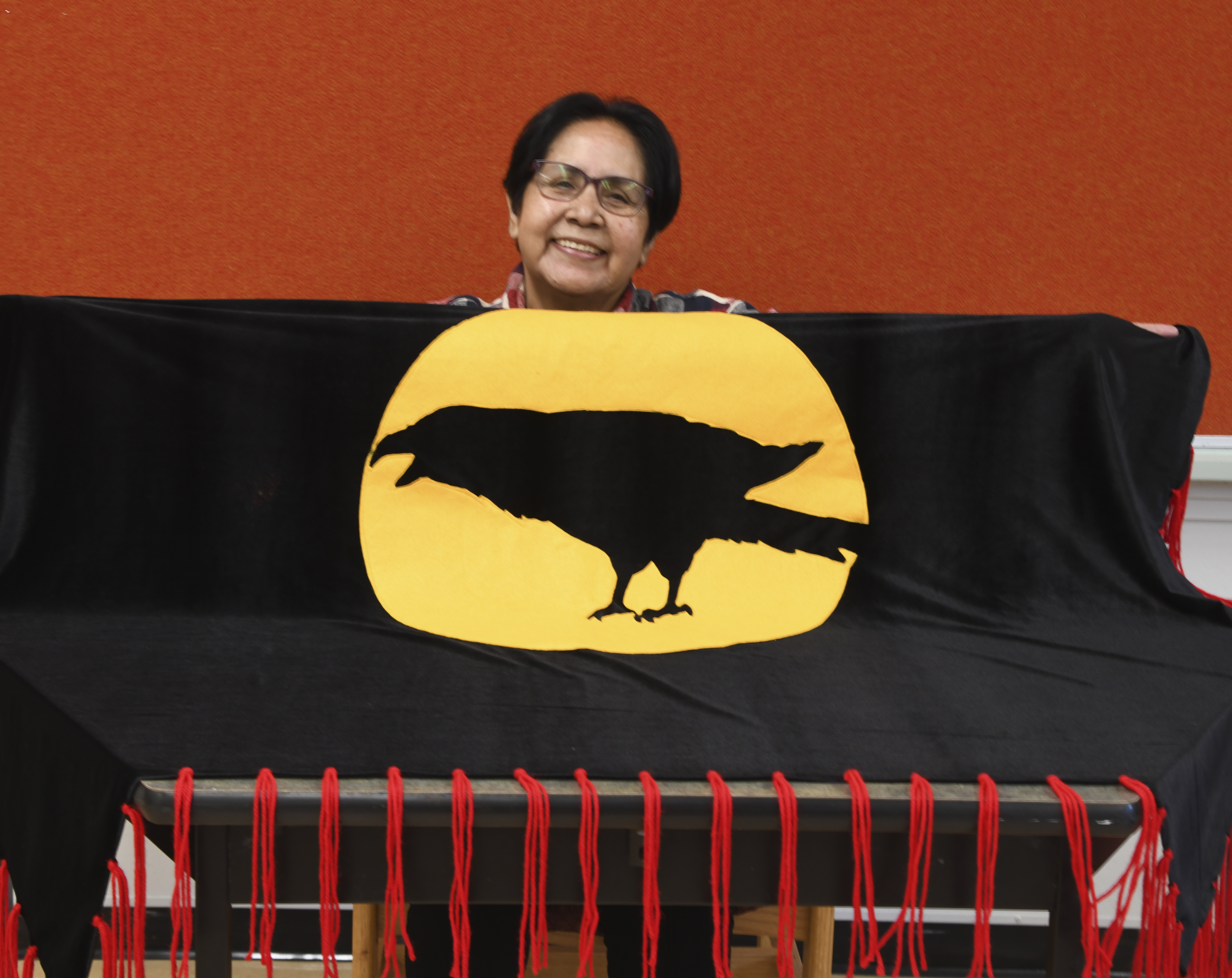
Kathy Martin
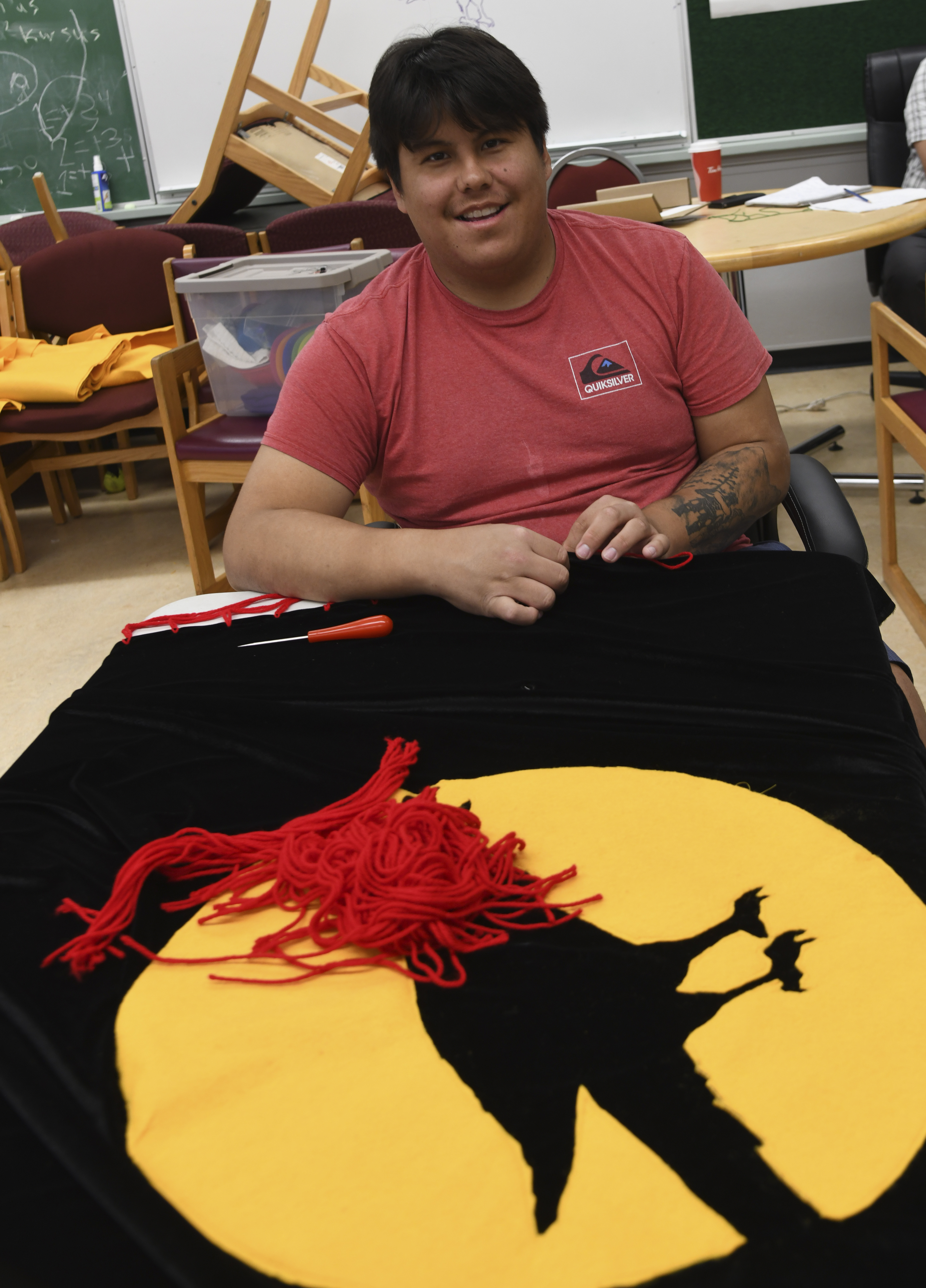
xunimtsun Cordell Jack
t’atulh mustimuhw
| (1) |
nanulh ’uw’ tl’i’st-hwus tthu Hul’q’umi’num’ mustimuhw tthu lushaan, lushaans tthu slhunleni’.
|
|
The shawls are very important to the Hul’q’umi’num’ people, the ladies’ shawl.
|
|
| (2) |
’i’ nilh tthu sluwi’s tthu xpey’ulhp ni’ hakwushus kwsus xut’eem’ ’u tthu lushaan, tthuw’ t’at mustimuhw.
|
|
The olden people used to make their shawls out of red cedar.
|
|
| (3) |
ni’ kwunutus tthu sluwi’ susuw’ yukw’utus ’i’ ni’ tth’asutus, nilh sus ’uw’ hwu mul’ul.
|
|
They rubbed and pounded the inner cedar bark until it was really soft.
|
|
| (4) |
niilh ni’ hakwushus kwsus xte’um ’u tthu napus.
|
|
And then they wove them into capes.
|
|
| (5) |
kwsus yu t’ut’uy’um’tus tthu stl’its.
|
|
At first they were just made with geometrical designs.
|
|
| (6) |
’i’ ’uw’ nilh ’ul’ tthu sxul’ ni’ yu they’tus kwsus nuts’tul tthu shnulhalusth tthu sluwi’ nilh ni’ t’uyum’tus ’u tthu napus.
|
|
But later they started weaving it with their family logo.
|
|
| (7) |
nilh ni’ shsp’ip’ut-ste’wut tthu ni’ st’i’am’, sxul’s tthu napus, ’i’ nuw’ sxuxits ’uw’ nilhus tun’untsu ’u tthu ts’lhhwulmuhws.
|
|
Each family recognized where they came from.
|
|
| (8) |
nilh tthu slhunlheni’ ni’ hay ’ul’ ni’ si’em’stum kwsus ha’kwushus tthey’ napus.
|
|
The ladies of high esteem wore the capes.
|
|
| (9) |
’i’ tun’a kweyul tthu slhunlheni’ ’i’ patun tthu ni’ thuytus ni’ xte’um ’u tthu lushaan.
|
|
Today, the ladies wear shawls, and these are made out of material.
|
Vocabulary
| lushan | shawl |
| s’iluw’s | fringe |
| tth’umq’t | cut the end off |
| p’etth’ut | sew |
| p’ep’utth’ul’s | sewing |
| ’akw’ut | hook it |
| ’ukw’alus | hook a loop |
| s’a’kw’ | hooked |
| shhw’a’kw’ul’s | crochet hook |
| xuthinumutth’ | four strands |
| muqw | thick |
| ’uhwiin’ulus | thin loop |
| suq’ | rip |
| nuts’alus | one loop |
| q’ul’q’ul’exunum’ | wrap around arm |
| kwum’tth’ul’exun’ | elbow |
| tslhaqwt | push it through |
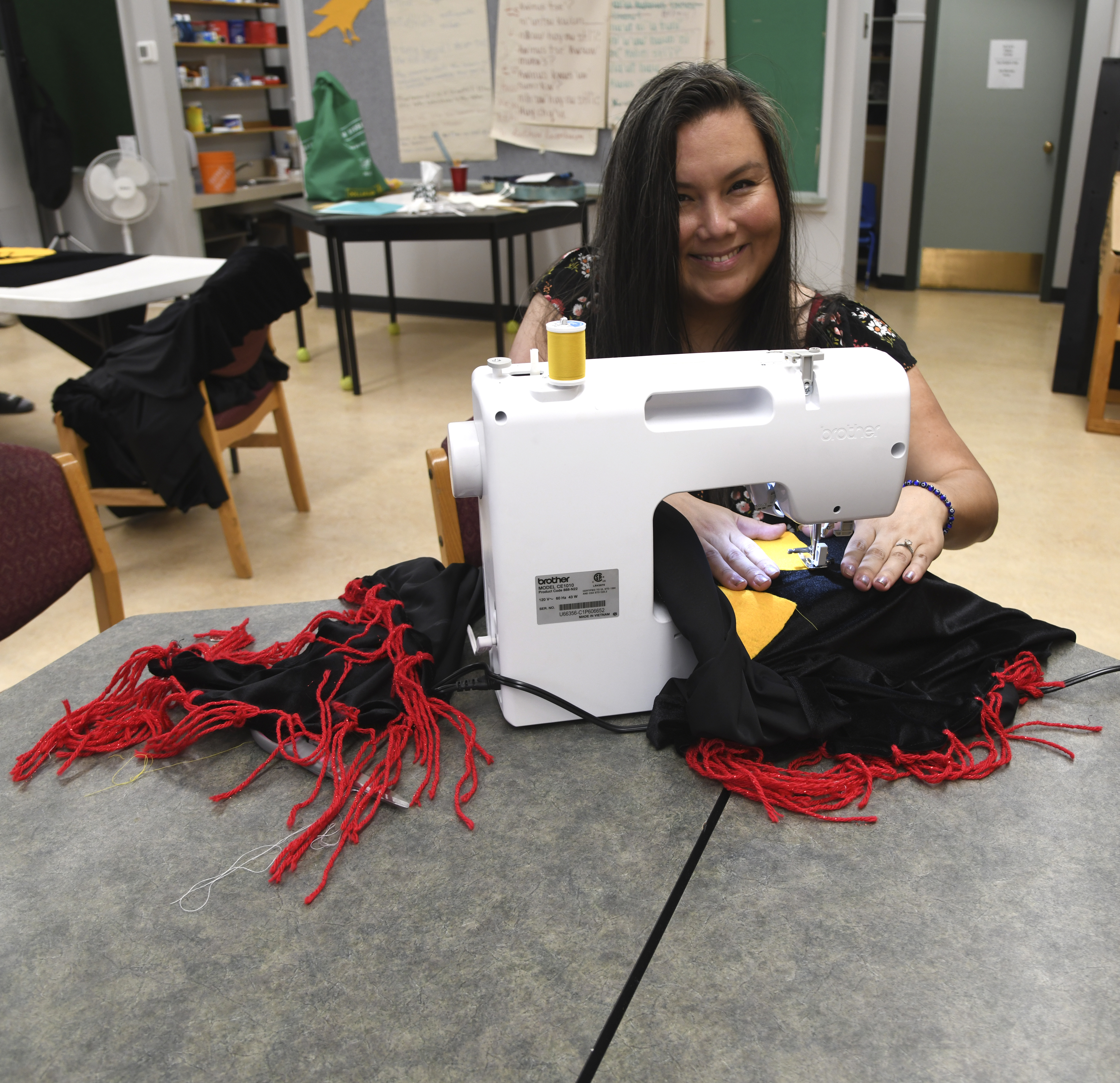
Roberta V Charlie
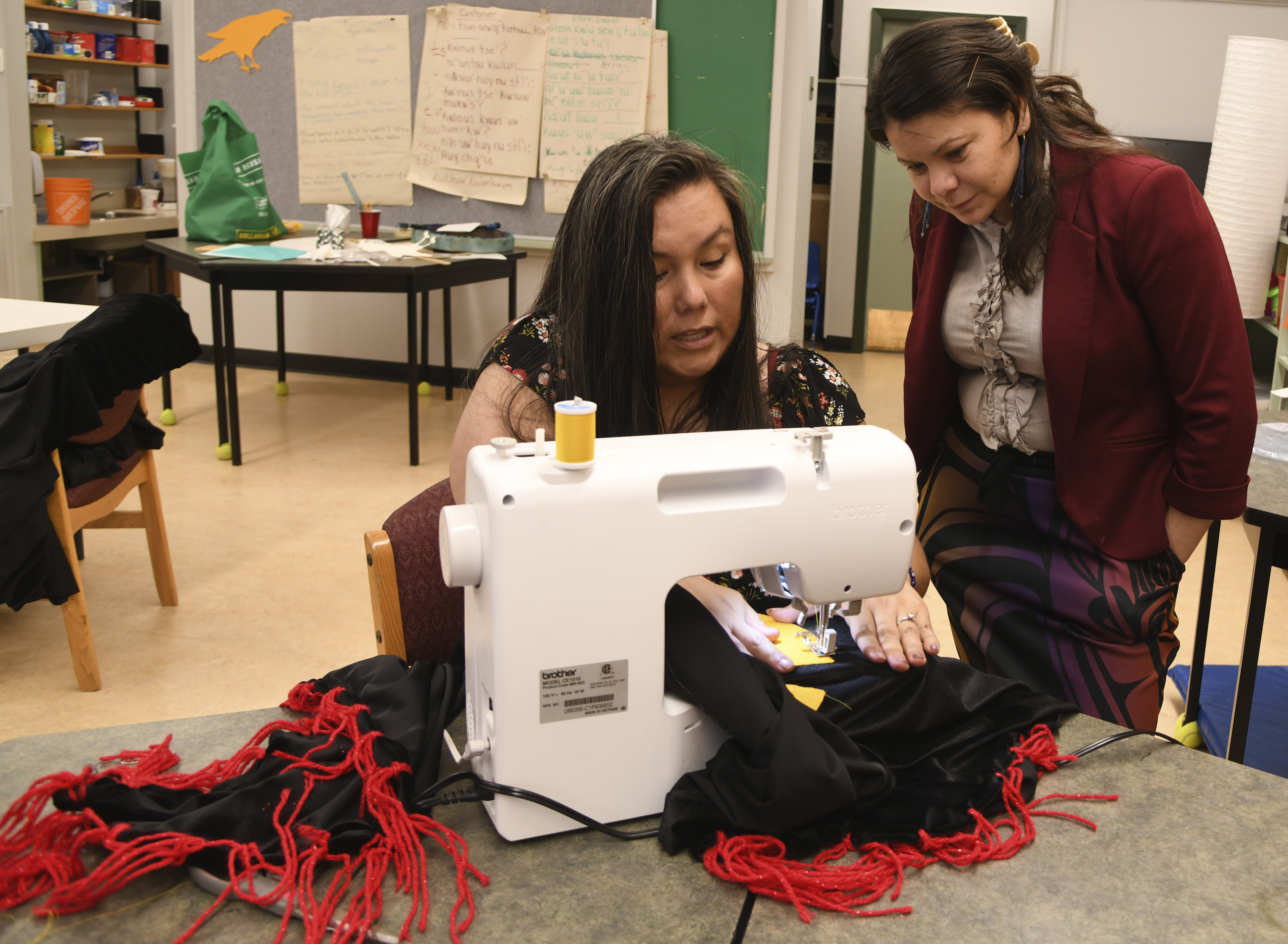
Roberta and qwulipulwut Maryann Dick
kwun’s xut’eem’ ’u tthu lushaan
How to make a shawl
Laura Antoine and Sally Hart
with help from Ruby Peter, Delores Louie, and Donna Gerdts
| (1) |
’u tun’a kweyul ’i’ xte’um tse’ ’ukw’ lushaan.
|
|
Today we are going to make a shawl.
|
|
| (2) |
nilh ha’kwushus tthu slhunlheni’ ’u kws nem’s ’u thu thi lelum’.
|
|
This is what the ladies wear when they go to the longhouse.
|
|
| (3) |
kwun’s xuxeetth’t tthun’ patun
|
|
Measuring the material
|
|
| (4) |
tthuw’ hwun’a’ ’ul’ ’i’ ni’ch tse’ xeetth’t tthu sht’es kwthu hakwushuhw ’u tthu patun.
|
|
The first thing to do is to measure the material that you are going to use.
|
|
| (5) |
nilh ni’ ’ulh sht’es tthu syuw’en’tst kwsus yu xuxeetth’tus tthu hakwushus.
|
|
This is the way our ancestors used to measure the material they were going to use.
|
|
| (6) |
tthu syuw’en’tst nilhulh tthu t’eluw’s ni’ ha’kwushus kwus xuxeetth’tus tthuw’ stem ’ul’ ni’ syaay’usth.
|
|
As for our ancestors, it was their arms that they used when they measured whatever they were working on.
|
|
| (7) |
tun’a st’e ’u tthey’ ’i’ nilh tse’ tthu measuring tape nilh tse’ hakwusheen’.
|
|
Right now I will use the measuring tape on what I am making.
|
|
| (8) |
t’xumulhshe’ inch ’i’ tthu xu’athun nilh sht’es kwsus tl’eq’t tthu patun.
|
|
Sixty-four inches is the length of the cloth.
|
|
| (9) |
lhq’utssulhshe’ toohw inches tthu sht’es kws lhq’et-s.
|
|
Fifty-nine inches is its width.
|
|
| (10) |
kwun’s wulh tth’um’q’t tthun’ patun
|
|
Cutting the material
|
|
| (11) |
lemut ch tthun’ patun kws tl’lim’s ’uw’ yu sul’iq’tul’ tthu lhq’een’s —’uwu niis yu spapi’.
|
|
See that your material is even on both ends — it can’t be crooked.
|
|
| (12) |
lemut ch thun’ patun ’uw’ niis ’uw’ mukw’ ’uw’ ’i sul’iq’tul’.
|
|
Look at your cloth — whether all are even with each other.
|
|
| (13) |
kwun’s wulh tth’um’q’t tthun’ patun.
|
|
Cutting your cloth
|
|
| (14) |
yelh kwu’elh nu tth’um’q’t tthu s’il lushaan tse’.
|
|
Now I will indeed cut the cloth that will be the lushaan.
|
|
| (15) |
hwlum’ust tthu patun ’u tthu thume’ ’un’s ni’ ’uw’ yu ts’aqw’t ’u tthu pin heads.
|
|
You fold the material twice and pin it.
|
|
| (16) |
kwthu ni’ hwlum’ustuhw thume’, nilh tse’ ni’ shni’s kwthu s’iluw’s kwun’s kwoonstuhw kws ’uwus nem’us yu qiil’qulul’.
|
|
You fold it twice, this is where you are going to attach the fringe so it won’t get ruined (frayed or unravelled).
|
|
| (17) |
kwun’s wulh ha’kwush thu shp’e’p’utth’ul’s
|
|
When you start using the machine
|
|
| (18) |
’u kwun’a’ yuw’en’ tthu syuw’en’tst s’ul’eluhw niilh ’uw’ nilh ’ul’ tthu tselushs hakwushus ’u kws p’e’tth’ut-s tthuw’ stem ’ul’ ’i’ tun’a qe’is ni’ ha’kwushus tthu shp’e’p’utth’ul’s.
|
|
Before our ancestors used their hands to do the sewing but now they use the sewing machine.
|
|
| (19) |
kwun’s hwun’a’ tuw’ p’e’tth’ut tthu ni’ yu hul’mutuhw ’i’ ni’ wulh sul’iim’ susuw’ sts’uts’aqw’at ’u tthu pin.
|
|
When you first start sewing what you have folded, which is already folded and pinned…
|
|
| (20) |
ni’ ch lheq’ut tthu sxun’us thun’ shp’e’p’utth’ul’s wulh nilh ’ul’ ’un’s nuw’ ’imushstuhw thu shp’e’p’utth’ul’s.
|
|
Put down the foot of your machine, and then you start sewing with your machine.
|
|
| (21) |
ni’ ch tus ’u tthu nuts’a [pin] ni’ sts’uts’a’qw’ ’un’s nuw’ me’sh ’i’ ni’ ch tl’e’ wulh p’etth’ut.
|
|
When you sew and reach the next pin, you take it out and continue sewing.
|
|
| (22) |
ni’ ch yu hum’ush tthu ni’ sts’uts’aqw’ ’i’ nuw’ tus ’ul’ ’u kwthu lhq’een’ kwun’s ni’ yu p’ep’utth’ul’s.
|
|
You keep removing the pins that are in the fold until you reach the end of what you are sewing.
|
|
| (23) |
kwun’s ni’ wulh tus ’u kwthu lhq’een’ ’i’ ni’ ch hwi’ hwu’alum’, hwu’alum’stuhw thun’ machine [shp’ep’utth’ul’s] kws ’uwus niis yuxw tthun’ syaays.
|
|
When you reach the end you go back (reverse) so it won’t unravel.
|
|
| (24) |
nilh kwun’s ni’ wulh ’usup’nuhw tthu ni’ yu p’ep’utth’utuhw ’un’s nuw’ me’sh ’i’ lemut, me’sh ’un’ suw’ lemut tthun’ lushaan kws tl’lim’s nuw’ yu sthuthi’.
|
|
When you finish what you have been sewing, you take it off and look at it, to see if it is okay.
|
|
| (25) |
xetst kws tl’eqt-s tthu s’iluw’s
|
|
Measuring the fringe
|
|
| (26) |
nu stl’i’ kwunus lum’stamu ’u tthu nilh sht’es thunu te’ kws thuytus tthu s’iluw’s.
|
|
I want to show you the way my te’ used to make her fringe.
|
|
| (27) |
niilh kwun’etus tthu lumutoul’qun susuw’ suse’st-hwus tthu tselushs.
|
|
She used to have her wool and she’d hold up her hand.
|
|
| (28) |
susuw’ kwun’etus tthu lumutoul’qun ni’ ’u tthu tselushs.
|
|
She would hold the wool in her hand.
|
|
| (29) |
susuw’ hwulukw’tus xwte’ ’u tthu kwumtth’ul’exun’s.
|
|
Then she’d go around her elbow.
|
|
| (30) |
nilh niilh shte’s kwus xuxeetth’tus tthu s’iluw’s ni’ they’tus.
|
|
And that’s the way she used to measure hers.
|
|
| (31) |
yelh sus t’qw’atus tth’umq’tus.
|
|
And then she’d cut it.
|
|
| (32) |
’uwu tsuniin’ st’e ’u lhunu te’ kwunus thuyt.
|
|
But I want it even and I’m not as good as my te’.
|
|
| (33) |
nilh tse’ kwu’elh tthu poukw hakwusheen’ kwunus xeetth’t thunu lumutoul’qun.
|
|
So I am going to hold the yarn and I’m going to use the book to measure the yarn.
|
|
| (34) |
’uwu tse’ nilhus thunu t’eluw’ kwumtth’ul’exun’ hakwusheen’ ni’ tse’ tthu poukw.
|
|
I’m not using my arm and elbow to measure; I will use the book.
|
|
| (35) |
kwunus wulh tth’umq’t tthu s’iluw’s
|
|
Cutting the fringe
|
|
| (36) |
tth’umq’t tthu lhq’een’ ni’ sti’am’ ’u tthu poukw ni’ ’u tthu tl’itl’up.
|
|
Cut the end that is attached to the book at the bottom.
|
|
| (37) |
ni’ wulh hwu saay’ kwun’s t’uy’um’t tthu s’iluw’s ’u tthun’ patun.
|
|
You are ready to attach the fringe to the cloth.
|
|
| (38) |
kwun’s ’uw’ hwun’a ’ul’ xtsut kwthun’ shhw’a’kw’ul’us tse’.
|
|
Choose a crochet hook.
|
|
| (39) |
nilh kwthu ’uw’ stl’atl’um’ ’ul’ hakwushuw ’u kwthun’ shhw’a’kw’ul’us.
|
|
You want to use the right hook.
|
|
| (40) |
ha’ ch hakwush kwthu nan’ ’uw’ muqw ’i’ suq’ kwthun’ patun.
|
|
If the hook is too thick, it will rip the material and there will be a hole.
|
|
| (41) |
’i’ ha’ ’uhwin’ulus kwthun’ shhw’a’kw’ul’us ’i’ skw’ey kwun’s ’akwut tthun s’iluw’s.
|
|
If the hook is too thin, it will not hook the fringe.
|
|
| (42) |
yuse’lumutth’ tthu ni’ t’uyum’tuhw ’u kwthu shhw’a’kw’ul’us ’i’ ni’ ch tslhaqwt ’u kwthu ni’ lumutuhw ’un’ patun.
|
|
Put two strands on the crochet hook and put it through the material that you have hemmed.
|
|
| (43) |
susuw’ hwu xuthinumutth’ tthun’ s’iluw’s ni’ hwu sti’am’ ’u tthun’ patun.
|
|
And now you have four strands on your material.
|
|
| (44) |
nem’ ch tslhaqwt tthun shhw’a’kw’ul’us ’u tthu s’iluxun’s tthu patun.
|
|
First push the crochet hook through the material right at the corner.
|
|
| (45) |
’akw’ut tthu s’iluw’s ’un’ suw’ tslhaqwt ’u tthu nuts’alus.
|
|
Hook the fringe and pull it through, just enough to make a loop.
|
|
| (46) |
luq’ut tthun’ s’iluw’s kws tl’lim’s ’uw’ sul’iq’tul’
|
|
Adjust the ends of the fringe so they are even.
|
|
| (47) |
ni’ wulh saay’ tthun’ s’iluw’s ’i’ ni’ ch kwunut tthun’ patun, tslhaqwt tthun’s shhw’a’kw’ul’s.
|
|
When your fringes are ready, you take your material and you put your hook through.
|
|
| (48) |
’un’s muw’ ’akw’ut tthu s’iluw’s ’i’ tslhaqwt ’u tthu patun.
|
|
Then you hook your fringe and pull it through the cloth.
|
|
| (49) |
kwsus wulh hwu stslhaqw ’u tthu patun ’un’ sni’ hwi’ nilh tthu lhq’een’s ni’ ’un’sh nem’ kwun’s m’i ’akw’ut ’un’s ’uw’ tslhaqwt ’u tthu ni’ tslhaqwtuhw ’u tthu patun, tslhaqwt ’u tthu nuts’alus ni’ stslhaqw ’u tthu patun.
|
|
When it has been pulled through the cloth, you catch the ends of the fringe and put them through (the loop) what you already pulled through the cloth, the one loop that was pulled through the cloth.
|
|
| (50) |
’un’s ’uw’ tslhaqwt tthun’ s’iluw’s susuw’ hwu s’a’kw’ ’u tthun’ patun.
|
|
And you put the fringe through the one that you put through the cloth and then it’s hooked to the cloth.
|
|
| (51) |
’un’s ’uw’ tqwut nem’ hwkw’at nem’ hwkw’at ’i’ tqwut.
|
|
And then you tighten as you pull it.
|
|
| (52) |
’i’ nilh susuw’ hwu saay’ tthun’ s’iluw’s.
|
|
And that’s how to finish the fringe.
|
|
| (53) |
’uw’ nilh ’ul’ thunu qulum’ ni’ yu xetst tthu ni’ sht’es kwus yu stutastul’ tthu s’iluw’s kws ’uwus yu nuts’tul’us yath ’uw’ yu sul’iq’tul’.
|
|
I’m just using my eye to measure the way that the fringe is spaced so that the spacing is not different but always even.
|
|
| (54) |
tl’lim’ nuw’ nuts’a skweyul kwun’s yaay’us ’u tthu lushaan ’i’ nilh sht’es kwun’s ni’ ’usup’t tthun’ syaays.
|
|
It takes one whole day to make a shawl, and that’s how you finish up your work.
|
|
| (55) |
nilh ha’kwushus tthu hwulmuhw slhunlheni’ ’u kws hunum’s ’u thu thi lelum’.
|
|
And this is what the First Nations ladies wear in the longhouse.
|
|
| (56) |
’uli’uy’mut lushaan.
|
|
The shawls are really beautiful.
|
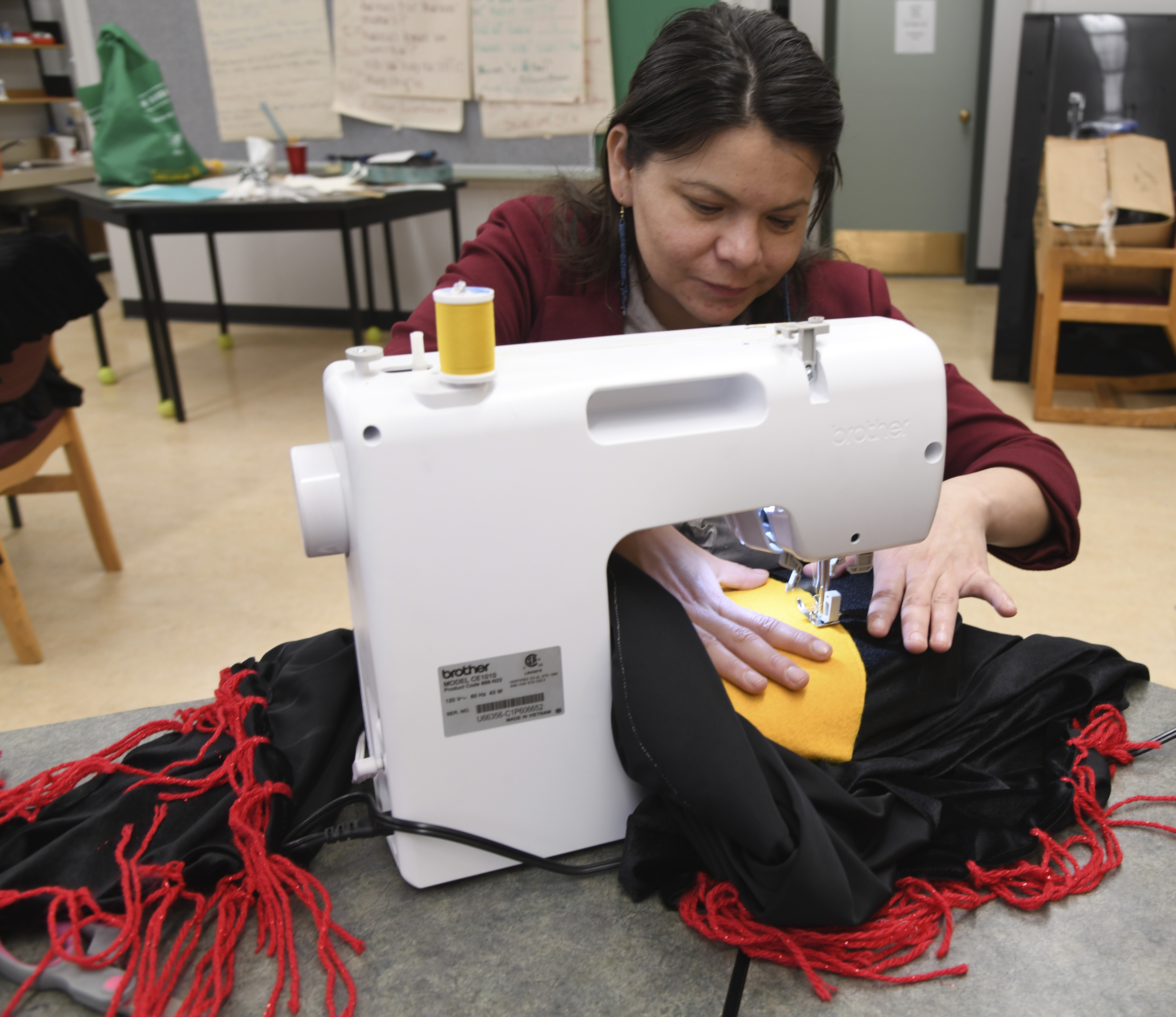
qwulipulwut Maryann Dick
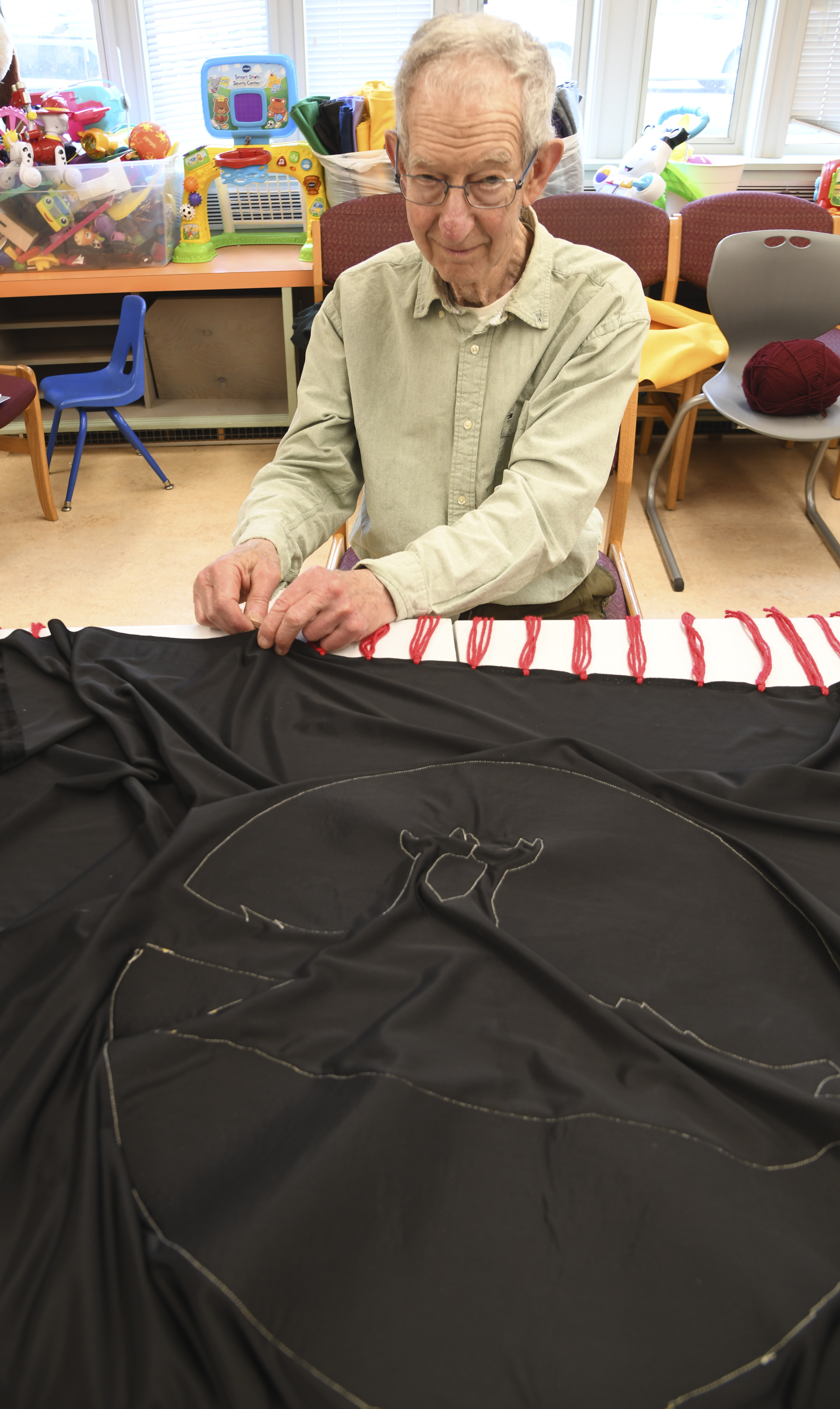
Richard Tarnoff
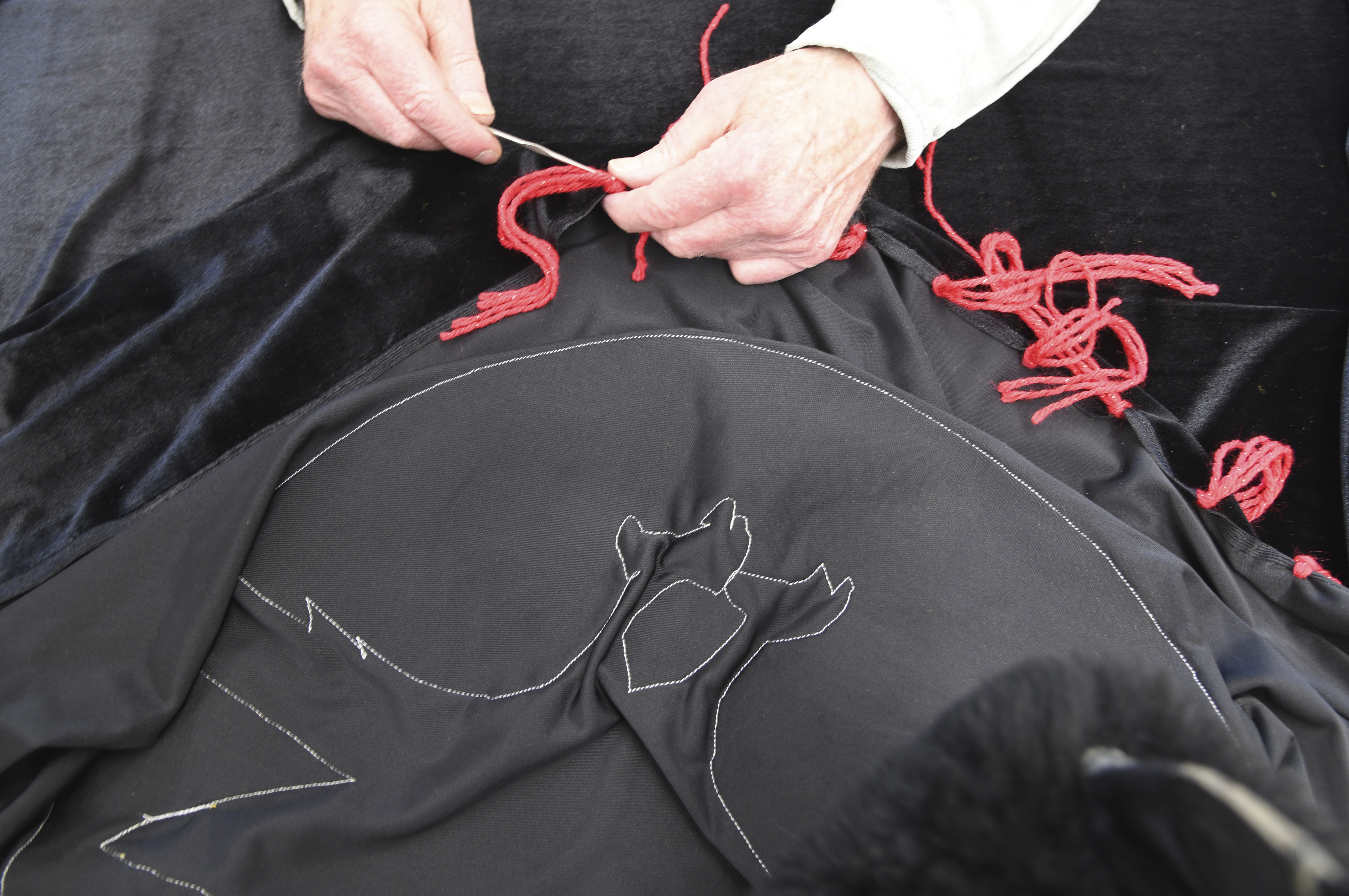
Richard Tarnoff
